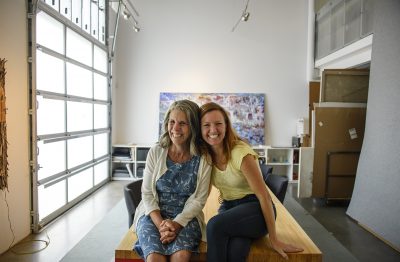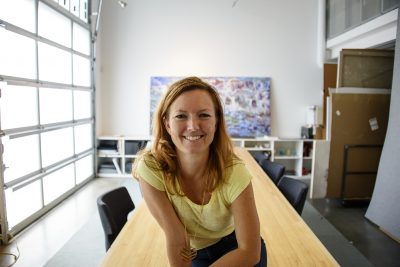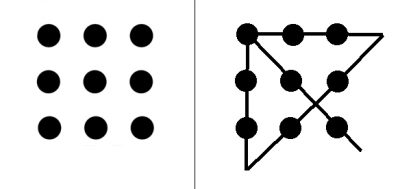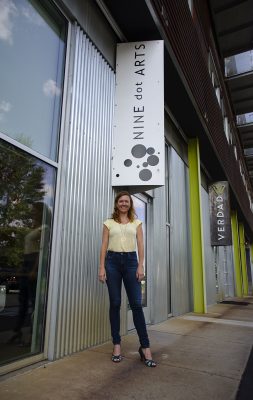As the GREGORY ALLICAR MUSEUM OF ART re-opens its expanded galleries on Saturday, Sept. 10, MARTHA WEIDMANN of NINE dot ARTS, a Denver-based corporate art advisory firm, will join Mayor Troxell on the dais for the ribbon cutting ceremony. Over the past few months, the Colorado State University art alumna has been leading the museum’s Honorary Alumni Committee in charge of promoting the grand opening in the Denver area.
Over a Black Black Coffee – the shop that claims to curate the world’s best coffee and doesn’t offer cream on the premises – the delightfully vivacious entrepreneur of NINE dot ARTS outlined a circuitous career path that, through tenacity and luck, has caught up to where it started, in Fort Collins.
With a B.F.A. in photography and a B.A. in communications, Weidmann and her husband left CSU and Fort Collins in 2005, heading to Denver in search of employment; a position in a gallery seemed the best approach for utilizing her skills as she hoped to articulate her art knowledge to potential buyers.
 Also present for our coffee date was Linny Frickman, director of the Gregory Allicar Museum of Art. Frickman was pleasantly reminded that she had originally connected Weidmann to Denver art aficionado Erike Schumake, then working at Rule Gallery, who generously introduced Weidmann to several gallery owners throughout the city; Weidmann’s first real job was at Walker Fine Art, where, for $10 an hour, she helped hang shows, painted walls, and cleaned up after parties. The enthusiastic young employee didn’t care what she did, she “had a job in a gallery, and it was the coolest thing ever!”
Also present for our coffee date was Linny Frickman, director of the Gregory Allicar Museum of Art. Frickman was pleasantly reminded that she had originally connected Weidmann to Denver art aficionado Erike Schumake, then working at Rule Gallery, who generously introduced Weidmann to several gallery owners throughout the city; Weidmann’s first real job was at Walker Fine Art, where, for $10 an hour, she helped hang shows, painted walls, and cleaned up after parties. The enthusiastic young employee didn’t care what she did, she “had a job in a gallery, and it was the coolest thing ever!”
In addition to the gallery, Weidmann made ends meet by working as an aerobics instructor, as a photographer shooting slides of other artists’ work, cataloging the impressive private collection of Peter and Philae Dominick (another connection made through Schumake), and writing for various arts magazines. “I had all of these totally random gigs to make it work,” she reminisced. “But working at the gallery, where I met so many wonderful, amazing working artists fed my soul.”
With a high overhead and low profit margin, gallery business was, and remains, tough, and Weidmann had an idea for supplementing the rent. “With almost no overhead, we realized the gallery could make more money if they rented out their space for parties.”
In charge of keeping an eye on the art at a large event for Miss. Gov. Haley Barbour, Weidmann entered into a discussion about Phoebe Knapp’s sculptures out of deadwood from the Camino Real, eagerly describing the life and beauty she saw in wood itself. “By the end of the evening, this couple wanted to buy Pheobe’s sculptures, $40,000 worth, and I didn’t even know what to do because really, I was just the floor sweeper,” she laughed. “I took their names and number, and in the morning, I told my boss that we had to call them back. She was amazed because no one in the gallery had ever made a single sale that big!”
Despite a promotion and dropping a couple of her other jobs – Weidmann was still working many nights and didn’t see her husband much – she found herself asking, “How do you make a career with these hours and lack of structure?”
NEGOTIATING HER FUTURE
Known for installing art in corporate spaces, the consulting firm of McGrath and Braun unexpectedly recruited Weidmann, who appreciated the structure appropriated by combining arts and business. “It was the crème de la crème [of jobs] for me because it was real art, with interesting clients and real hours, and I was going to stay there forever!”
During the 2009 recession, it became apparent to Weidmann that McGrath and Braun would not survive. The business was sold and subsequently went bankrupt under the new ownership, leaving clients and artists unpaid. Weidmann’s pathway bent again.
“I knew if these artists didn’t get paid, I would never get to show may face again,” she said. Weidmann and her remaining co-worker, Molly Casey, agreed to forfeit tens of thousands of dollars’ worth of commissions owed them in exchange for three things: all of the artists got paid; three outstanding contracts were transferred to them; and the new owners called every client, recommending Weidmann and Casey as the new consultants.
In the aftermath of the negotiation, and with guidance from their mentors, Maeve McGrath and Jette Braun, the two entrepreneurs founded NINE dot ARTS, a firm that curates permanent collections in corporate settings. “In 2009, I had a one-year old, was pregnant, and my husband’s landscape architecture career was stagnant. [As the] only one with a job in the family, I had to make this work!”
Working out of a tiny, hot back room in an architecture firm, NINE dot ARTS was a bootstrap, start up. “When you don’t have assets, you start a service-based business,” confirmed Weidmann. “We still had relationships with the clients and artists and were able to carry on.”
One year in, NINE dot ARTS was hired for a job so large they questioned their ability to take it on and reached out to their former companies’ founders, McGrath and Braun for assistance; the project was so successful that 18 months later, their two mentors made back everything they had originally lost in the bankruptcy, and remain connected to NINE dot ARTS to this day.
Weidmann’s passion for the transformative power of original art is reflected in her company’s name. If you’ve not seen the nine dot puzzle, the challenge is to, without lifting your pencil from the paper, connect nine dots with four straight lines; the puzzle can only be solved by going outside of the natural box created by the dot edges. Here is one solution:
“Some corporate art is done by looking at the décor and figuring out how to match the art,” declares Weidmann. “[We] tried to get people out of that box right from the beginning.”
Weidmann begins by asking clients what they want the art say about their company; a company’s culture, image, stability, longevity, and diversity are some of the key areas explored as NINE dot ARTS curates a collection that tells a client’s whole story.
Additionally, an installation should spark dialogue, perhaps privately among employees or publically between visitors. “Art should be a way to create thought and discussion and new and original ideas among everyone,” said Weidmann.
Finally, Weidmann recommends a crucial ratio of thirds, encouraging clients to select equal parts art they find spectacular; art they are ambivalent about; and art they hate. “It is critical that [they] don’t pick the things that everyone agrees upon because they’ll pick the lowest common denominator – what’s in your bottom third will be in someone else’s top,” she explained.
Weidmann’s bottom third – poster and catalog art – is her biggest competition. “I’m trying to convince business owners that if it is a mass produced product, it isn’t real art. As a business or institution you should spend [your] dollars on living creative people because it supports the economy where you are.” And for Weidmann and Casey, supporting the work of living artists is the main reason NINE dot ARTS exists.
As expressed in NINE dot ARTS’ intelligently conceived online blog, “Art is not merely a product, something to be bought and sold. It’s at once tangible and intangible. For the businesses we work with, art provides multiple values: activating and humanizing spaces, creating unforgettable environments, and attracting and retaining talent and customers. How can you put a monetary value on those things?”
In the end, the model has been successful and NINE dot ARTS is thriving.
 PROUD OF HER LIBERAL ARTS EDUCATION
PROUD OF HER LIBERAL ARTS EDUCATION
As the three of us started on a second cuppa, the conversation shifted back to Colorado State University and Weidmann’s liberal arts education, an education that, for her, substantiates the idea that people can live out their passions in real life. “I feel like being in school and having a degree in studio [photography] and communications validated and acknowledged that it was part of who I am and who I will always be,” she said. “Plus, no one finishes a studio degree who damn well didn’t want it because of the commitment and the hours.”
When Weidmann meets people without relevant degrees looking for a job in the arts, you could say her red-headed frame of mind bristles. “If you don’t have formal training, then how many years have you put in to try to study this? We all have that moment of thinking ‘what the hell am I going to do with an art degree?’”
But Weidmann was always determined and committed to not just make a living, but to make a difference, in the field of art. “This is me and I can’t pretend to be someone else…there is no other option and when you get to the fork in the road you follow your heart!”
Idealistic art students often downplay the importance of money, but to the core, Weidmann believes in the co-existence of art and business, explaining that there are ways to value work and one way is in exchange, including the exchange of money. “I don’t feel it shouldn’t be poo-pooed like it can be in academia. It’s one way people show value for one another.”
Weidmann paraphrases an influential Albuquerque-based artist, Marietta Patricia Leis, “You have to be just as creative in the ways that you make money as in the ways you create your art. You can either grow into your passion where it becomes your joy, or your source of life, or you become a cynic.”
THE MUSEUM AS A DISTINGUISHING FORCE
As Weidmann has stayed connected to the Art Department, including Frickman, she is thrilled about the distinction the Gregory Allicar Musuem of Art brings to CSU. “In the uphill battle for Fort Collins to be recognized as a prestigious contributor to the art world, it further establishes us as a hub for fine arts, providing intellectually engaging content for the community.”
Frickman agrees that the museum has already and will continue to bring attention to the program. “Our faculty is the strongest it has ever been, but sometimes not as recognized in the Denver scene, maybe because of the distance,” she said. Through Weidmann and other alumni, connections in Denver are contributing to that awareness.
Weidmann feels that the University Center for the Arts and the Gregory Allicar Museum of Art, although not completed when she graduated, adds value and prestige to her degree, even after the fact. “It’s like we were building up to the standards we already held ourselves to.”
In addition to returning to Fort Collins in support of the expanded museum, NINE dots ARTS latest project is the curation of Pat Stryker’s new, downtown boutique hotel, The Elizabeth Hotel, where she, along with CSU art faculty, alumni, and students, is examining the overlap of music and art, including direct influences and abstract connections. Weidmann also revels in wearing a hard-hat and heading to the construction site, working with contractors, the design team, and electrical and structural engineers alike. “You have to figure it out in the early stages, accounting for everything like how to hang the sculptures and light framed works before the walls are sealed.”
Although Martha Weidmann claims luck as an element to her success, once you meet this ebullient businesswoman, it’s apparent that pure grit and commitment to working hard at something she loves created all the breaks she needed.
ABOUT NINE dot ARTS
NINE dot ARTS believes in the power of original art to transform an environment into an experience. Through innovative art programs we aim to inspire and stimulate our clients and their communities. As a national art consulting firm with annual revenues over $4 million, NINE dot ARTS works with corporate clients including hospitals, hotels, law firms, real estate developers and government agencies to curate permanent art collections. NINE dot ARTS’ project roster includes Colorado Convention Center, Boston’s Hotel Commonwealth, Saint Joseph Hospital, Wheeler Trigg O’Donnell, SM Energy and TD Ameritrade, among others. The Huffington Post, Boston Globe, New York Post, Successful Meetings, Modern in Denver and The Denver Post have featured stories about NINE dot ARTS and its projects.

